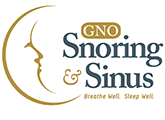Surgical Treatment of Severe OSA
Clinical History: Pt presented with a diagnosis of Severe OSA. CPAP was prescribed but the patient was unable to tolerate this form of treatment. The patient’s Body Mass Index was 33 at the initial visit, categorizing this individual as obese. Seeking further options, the patient presented to GNO Snoring and Sinus.
Physical Exam: A full airway examination in the office revealed blockage at the nasal and palatal region. This individual suffered from a Deviated Nasal Septum and Enlarged Inferior Turbinates, preventing proper nasal airflow. Furthermore, this individual had very large tonsils and a long soft palate. As a result, when the patient would lay down for sleep, the tonsils and palate tissue would fall back – causing full obstruction to airflow. Such blockage also contributes to the increased difficulty tolerating CPAP as well.
Treatment: The patient underwent a surgical procedure consisting of a Septoplasty, Inferior Turbinate Reduction, and Uvulo-palato-pharyngoplasty. This combination of procedures was designed to correct the obstructions created by the deviated nasal septum, large inferior turbinates, and obstructing tonsils and soft palate.
Results:
Pre-op Sleep Study (12/2014)
Apnea Hypopnea Index (AHI) : 38 (Severe OSA)
Body Mass Index (BMI): 33
Post-op Sleep Study (9/2015)
AHI: 7.7 (Mild OSA)
BMI: 31.3
Summary: Following the surgical procedure, the patient noted an improved ability to breathe both day and night. Furthermore, post surgical sleep study results revealed a reduction in severity of Sleep Apnea from Severe to Mild. Given the subjective improvement in breathing and energy,the objective improvement in sleep study results from Severe to Mild, and the lack of co-morbid health conditions worsened by Sleep Apnea(Heart Disease, Hypertension) – CPAP therapy was no longer required in this individual.
